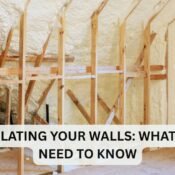Batt Insulation Vs Spray Foam Insulation: Which Method Is Appropriate

Batt Insulation Vs Spray Foam Insulation: Which Method Is Appropriate
When it comes to insulating your home, one of the primary decisions will be selecting between batt and spray foam insulation options. Both have advantages and disadvantages to consider before making an informed choice that meets all your specific needs and priorities.
Batt Insulation: Traditional and Cost-Effective Option
Batt insulation (commonly referred to as blanket insulation) has long been considered one of the go-to choices when it comes to insulation, often made out of materials like fiberglass or mineral wool and available as pre-cut rolls or blankets. Because its handling and installation processes are relatively straightforward, this form of insulation has proven popular with both DIY enthusiasts and professional contractors.
Installation and Cost
One of the primary advantages of batt insulation is its simple setup process, meaning homeowners with some basic knowledge and tools can perform installation themselves to potentially save on installation costs. Batt insulation typically fits between standard-spacing studs, joists, and beams making installation relatively straightforward in attics, walls and floors. At first glance, batt insulation tends to be more budget-friendly than spray foam insulation in terms of cost. Materials tend to be less costly, and professional installation often isn’t needed so that overall costs may be lower as a result – making batt an appealing solution for those on tight budgets.
Thermal Resistance Value (R-Value)
R-value measures the performance of insulation by its ability to prevent heat transfer. When installed properly with sufficient thickness and material thickness, batt insulation may offer acceptable R-values, though their R-value will depend on various factors including material and thickness considerations.
Pros and Cons of Batt Insulation
Pros:Cost-Effective: Batt insulation tends to be more cost-effective than spray foam in terms of both material costs and installation expenses, saving on professional installation fees.
DIY Friendly: Homeowners with basic skills may install batt insulation themselves and save professional installation fees by doing it themselves. Batt insulation can be easily found at local home improvement stores and is accessible for many homeowners.
Cons:
Air Sealing: On the downside, batt may not provide as good an air sealing seal as spray foam insulation options and could create drafts and energy waste inefficiencies that compromise energy savings and efficiency.
Installation Quality: Poor installation can reduce the effectiveness of batt insulation by way of gaps or compressions in installation, leading to reduced efficacy.
Moisture Issues: If batt insulation is improperly installed it could trap moisture leading to mold growth as a result of moisture build up inside batt insulation if left laying around for too long; or improper moisture sealing with batt insulation leading to mold growth leading to other health related problems such as allergies and illness. Spray Foam Insulation Provides Superior Air Sealing Performances.
Spray foam insulation: Superior Performance and Air Sealing
Spray foam insulation, represents a more modern and advanced form of insulation, using an expandable foam mixture which hardens upon spraying into an enclosed space to form an airtight seal that outwits batt insulation systems.
Installation and Cost
Spray foam insulation often requires professional installation due to specialized equipment and expertise required in its proper application. Foam can then be sprayed onto desired areas to form an effective air barrier – adding cost but optimizing performance! Spray foam insulation typically incurs higher costs than its batt counterpart due to more costly materials and professional installation services required for its installation process; however, when considering its long-term advantages for energy savings and more comfortable living spaces it becomes essential.
Thermal Resistance Value (R-Value):
Spray foam insulation typically boasts higher R-values per inch compared to batt insulation options, enabling it to achieve similar levels of thermal resistance with reduced materials – making this method particularly efficient in spaces without enough room for traditional solutions like batt.
Pros and Cons of Spray Foam Insulation
Pros:
Spray Foam Insulation: Superior Air Sealing: Spray foam can create an airtight seal to decrease air leaks, drafts, and potential energy losses.
High R-Value Insulation: This material offers superior insulation performance with less material needed – an advantage when applied in areas with limited space available for insulation installation.
Moisture Resistance: Spray foam insulation offers excellent moisture-resistant qualities, helping prevent mold growth and other moisture-related problems. Contrast With Other Insulation Options (High Initial Investment Cost) These initial costs could discourage budget-minded homeowners.
Professional Installation: Requiring professional installation adds significantly to overall project costs and curing times; during which, occupants may need to vacate.
Curing Time (for spray foam projects only): Curing may take between one to four days after curing has completed and during that period may necessitate leaving occupants outside unless managed appropriately during that period (Cure Time Factors to Consider for Your Project). Factors to Consider for Your Project
When making the choice between batt insulation and spray foam insulation, several considerations come into play:
Budget: If budget constraints are an issue for you, batt insulation might be more economical. Air Sealing: When tight building envelope and reduced energy loss is of critical importance to you, spray foam’s superior air sealing properties might justify its higher upfront cost.
Installation: Are You Comfortable Installing It Yourself or Prefer Professional Installation Services? Space Constraints: Where space constraints prohibit insulation installation, spray foam insulation with higher R-Value per inch may provide more effective insulation solutions.
Conclusions: Finding an Appropriate Balance
Batt insulation and spray foam insulation both have their own set of advantages and drawbacks, and making the right decision depends on your unique set of needs, budget constraints and project goals. Batt insulation may provide the optimal cost-cutting option if you have confidence in your DIY abilities and you seek cost savings, however if air sealing, higher R-values, or energy savings is of particular concern spray foam insulation could prove more worthwhile as an investment option. At the core, it is crucial that you carefully assess your project requirements, consult insulation specialists, and compare upfront costs against potential long-term benefits in order to make an informed decision that ensures a more comfortable home that remains energy efficient for years to come.



